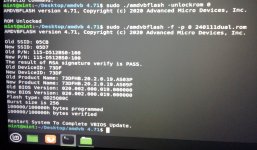I have been trying to flash the asus rx6700xt dual to the rx6700xt dual OC, the 2 are identical externally and internally the dual has a limit of 2800mhz and the dual oc 2950mhz
well, I tried with amdvbflash 4.71 in linux the command -unlockrom and the command -s and both were completed correctly

But when entering windows the adrenalin software blocked the frequency of the gpu at 500mhz, I cleaned the drivers with ddu and it did not work either ...
It is assumed that they are the same model only that one is artificially limited by bios, then the blocking is because it is a different chip?
Why have they taken the trouble to rename the chip internally and not just limit themselves to offering different bios?
it is unfortunate that amd removes the possibility of unlocking a chip of the same range to the maximum potential by any means ...
well, I tried with amdvbflash 4.71 in linux the command -unlockrom and the command -s and both were completed correctly

But when entering windows the adrenalin software blocked the frequency of the gpu at 500mhz, I cleaned the drivers with ddu and it did not work either ...
It is assumed that they are the same model only that one is artificially limited by bios, then the blocking is because it is a different chip?
Why have they taken the trouble to rename the chip internally and not just limit themselves to offering different bios?
it is unfortunate that amd removes the possibility of unlocking a chip of the same range to the maximum potential by any means ...
